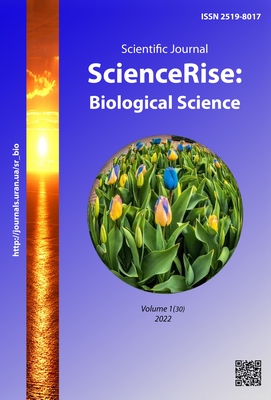Age dynamics of indicators of the microcirculation system in students according to laser dopler flowmetry
DOI:
https://doi.org/10.15587/2519-8025.2022.256233Keywords:
microcirculation of blood, laser Doppler flowmetry, age periods of ontogenesisAbstract
The article is devoted to the problem of studying blood microcirculation in healthy individuals at different stages of ontogenesis.
The aim of the study was to investigate the peculiarities of the skin blood flow in students aged 17-21.
Materials and ways of the research. In order to study the functional state of blood microcirculation the method of laser Doppler flowmetry (LDF) was used.
Results. Determination of the age dynamics of the tissue blood flow in subjects aged 17-21 years showed that the parameter of microcirculation in the subjects increased from minimal values at 17 years to maximal values at 21 years. In the female subjects, the value of the microcirculation parameter was higher at 17 years than in the male subjects, while the maximum perfusion value for girls was at 19 years and at 20 years in the male subjects. Assessment of the regulatory devices showed that the amplitude value of low-frequency oscillations in females fell at the age of 19 years and in males at 20 years. The maximal amplitude index of vasomotor oscillations was registered at the age of 19 years both for boys and girls. The amplitude of vasomotor oscillations in the high-frequency range varied in both girls and boys. Three types of LDF-grams were identified among the young adolescents: aperiodic LDF-grams, which correspond to normoemic type of microcirculation, monotonous low amplitude LDF-grams, which correspond to hypooemic type of microcirculation, sinusoidal LDF-grams, which correspond to hyperemic type of microcirculation.
Conclusions. As many studies have shown, the heterochronicity of values of blood microcirculation indices is preserved in male and female subjects: in one age section the indices are higher in females, in the other one – in adolescents. This fact reflects the general biological regularity of different maturation of male and female organisms
References
- Hulei, L. O. (2007). Obhruntuvannia kompleksnoi terapii vuhrovoi khvoroby u zhinok reproduktyvnoho viku z urakhuvanniam rivnia statevykh hormoniv ta stanu mikrotsyrkuliatsii shkiry. Kharkiv, 22.
- Stanishevska, T. I., Gorna, O. I., Berezhniak, A. S., Horban, D. D. (2015). Daily dynamic of indicators of girl-students’ blood micro-circulation. Pedagogics, Psychology, Medical-Biological Problems of Physical Training and Sports, 19 (6), 23–29. doi: http://doi.org/10.15561/18189172.2015.0604
- Martini, R., Bagno, A. (2018). The wavelet analysis for the assessment of microvascular function with the laser Doppler fluxmetry over the last 20 years. Looking for hidden informations. Clinical Hemorheology and Microcirculation, 70 (2), 213–229. doi: http://doi.org/10.3233/ch-189903
- Virabian, V., Danilina, T., Naumova, V., Zhidovinov, A. (2017). Otcenka sostoianiia mikrotcirkuliatcii sosudov s pomoshchiu lazernoi dopplerovskoi floumetrii. Vrach, 3, 74–75.
- Tankanag, A. V. (2018). Wavelet analysis methods in the comprehensive study approach of skin microhemodynamics as a cardiovascular unit. Regional Blood Circulation and Microcirculation, 17 (3), 33–41. doi: http://doi.org/10.24884/1682-6655-2018-17-3-33-41
- Chornomydz, I. B., Boiarchuk, O. R., Chornomydz, A. V. (2018). Perspektyvy vykorystannia lazernoi dopplerivskoi floumetrii v pediatrychnii praktytsi. Science Review, 2 (9), 61–65.
- Lenasi, H. (2011). Assessment of Human Skin Microcirculation and Its Endothelial Function Using Laser Doppler Flowmetry. Science, Technology and Medicine open access content, 13, 271–296. doi: http://doi.org/10.5772/27067
- Dunaev, A. V., Sidorov, V. V., Stewart, N. A., Sokolovski, S. G., Rafailov, E. U. (2013). Laser reflectance oximetry and Doppler flowmetry in assessment of complex physiological parameters of cutaneous blood microcirculation. Advanced Biomedical and Clinical Diagnostic Systems XI. doi: http://doi.org/10.1117/12.2001797
- Stoyneva, Z. (2012). Clinical application of laser Doppler flowmetry in neurology. Perspectives in Medicine, 1 (1-12), 89–93. doi: http://doi.org/10.1016/j.permed.2012.03.009
- Kozlov, V. I., Azizov, G. A. (2012). Lazernaia dopplerovskaia floumetriia v otcenke sostoianiia i rasstroistv mikrotcirkuliatcii krovi. Moscow: RUDN GNTc lazer. med., 32.
- Kozlov, I. O., Zherebtsov, E. A., Podmasteryev, K. V., Dunaev, A. V. (2021). Digital Laser Doppler Flowmetry: Device, Signal Processing Technique, and Clinical Testing. Biomedical Engineering, 55 (1), 12–16. doi: http://doi.org/10.1007/s10527-021-10061-7
- Osadchyi, V. V., Stanishevska, T. I., Gorna, O. I., Gorbatiuk, R. М., Melnychuk, I. M., Chernyaschuk, N. L. et. al. (2020). Method of using laser doppler flowmetry in assessment of the state of blood microcirculation system. Optical Fibers and Their Applications 2020. doi: http://doi.org/10.1117/12.2569778
- Mikhailov, P. V., Muravyov, A. V., Osetrov, I. A., … Muravev, A. A. (2019). Age-related changes in microcirculation: the role of regular physical activity. Research Results in Biomedicine, 5 (3), 82–91. doi: http://doi.org/10.18413/2658-6533-2019-5-3-0-9
- Stanishevska, T. I., Horna, O. I., Horban, D. D. (2021). Features of hemodynamics in pubertal and postpubertal stages of human ontogenesis. Bulletin of Zaporizhzhia National University. Biological Sciences, (1), 50–58. doi: http://doi.org/10.26661/2410-0943-2020-1-07
- Tikhomirova, I. A., Baboshina, N. V., Terekhin, S. S. (2018). LDF method capabilities in the estimation of age-related features of the microcirculation system functioning. Regional Blood Circulation and Microcirculation, 17 (3), 80–86. doi: http://doi.org/10.24884/1682-6655-2018-17-3-80-86
Downloads
Published
How to Cite
Issue
Section
License
Copyright (c) 2022 Оksana Gorna, Daria Horban

This work is licensed under a Creative Commons Attribution 4.0 International License.
Our journal abides by the Creative Commons CC BY copyright rights and permissions for open access journals.
Authors, who are published in this journal, agree to the following conditions:
1. The authors reserve the right to authorship of the work and pass the first publication right of this work to the journal under the terms of a Creative Commons CC BY, which allows others to freely distribute the published research with the obligatory reference to the authors of the original work and the first publication of the work in this journal.
2. The authors have the right to conclude separate supplement agreements that relate to non-exclusive work distribution in the form in which it has been published by the journal (for example, to upload the work to the online storage of the journal or publish it as part of a monograph), provided that the reference to the first publication of the work in this journal is included.









